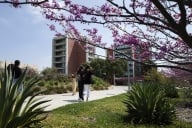You have /5 articles left.
Sign up for a free account or log in.
Derek Bruff, director of the Vanderbilt University Center for Teaching, believes that learning objectives should guide how college instructors use technology, not the other way around. In his new book, Intentional Tech: Principles to Guide the Use of Educational Technology in College Teaching, Bruff offers help to faculty members seeking to employ or tasked with further employing technology in their classroom.
Bruff responded via email to questions about his book.
Q: Your book offers help for instructors looking to meaningfully integrate technology into their classrooms. What do you think is holding most faculty members back from engaging with tech in the classroom in an intentional way?
A: It’s not always clear how to use some new technology to support student learning. Faculty and other instructors are usually comfortable knowing how to use, say, a chalkboard to facilitate classroom activities. But the landscape of digital and online technologies is changing rapidly, and we’re all still figuring out how to make the most of newer tools. I think the key is knowing what kinds of learning experiences you’re interested in creating for your students, then finding technologies that help support those experiences. And that process benefits from seeing how other instructors match technology to pedagogy, which is why I share a lot of stories of faculty teaching with technology in the book.
Q: Your book outlines seven teaching principles to inform the use of educational technology. Which of those principles do you think will be newest to faculty, or will surprise them the most?
A: One of the chapters focuses on using technology to make visible what Randy Bass calls “thin slices of student learning.” The more we understand what and how our students are learning, the more responsive we can be to their learning needs. Most educators know this, but I find faculty are often surprised at the roles technology can play in this kind of formative assessment. For instance, one of my favorite uses of Twitter in teaching is Margaret Rubega’s #birdclass assignment. She teaches an ornithology course at the University of Connecticut, and she asks her students to tweet about the birds they see as they go about their days. She’s interested in seeing how students transfer their learning outside the classroom, and she’s found just the right piece of technology to make that learning visible.
Q: Some of your suggestions and case studies involve relatively simple technologies, for example dry-erase boards, Twitter, blogging and Prezi presentations, while some newer and more disruptive innovations, such as adaptive learning, aren’t really touched upon. Why did you choose to focus on the technologies that you did?
A: When writing the book, I was mindful where faculty have the most autonomy, which is in the design of individual courses, activities and assignments. Those are areas where most instructors can decide to try something a little different, like a course blog or Twitter activity or digital storytelling assignment. I focused on technologies that would be useful in those contexts, across disciplines and institutions, and that have relatively small start-up costs, in terms of time and dollars. Adaptive learning, virtual reality, wearable tech … all of these have potential to enhance higher education, but these technologies usually require a lot of institutional buy-in. I’m happy to talk with administrators interested in pursuing these innovations, but the book is aimed at faculty who might be ready to make a useful change next semester.
Q: Digital natives are increasingly entering the faculty at colleges and universities. Do you believe they will come in with a different pedagogy or use technology in the classroom differently?
A: I was surprised to realize recently that it’s been 18 years since Marc Prensky coined the term “digital native.” So, yes, those young people he wrote about in 2001 are now entering the faculty. I think the digital native concept has always been problematic. Access to digital technology has never been universal among young people due to economic disparities, and even those who have grown up with internet technologies all around them often don’t think about those technologies as critically as they could.
If I had to identify a generational trend among higher education faculty, I would say that many younger faculty have seen and experienced more varied uses of technology in their own education than was the case back in 2003, when I started in faculty development work. I think this means their baseline is a little different with regard to the roles they imagine for educational technology.
That’s a good thing. Concurrently, however, we’re all more used to technology that “just works” in our personal lives, and that can create unrealistic expectations for educational technology. There’s a lot of value in being willing to push buttons and poke around when learning and applying a new technology, and I don’t know if I’m seeing more of that in today’s junior faculty.
Q: In your chapter on helping students find an authentic audience for their work, you mention some privacy concerns that faculty should consider. How can faculty members balance the security and privacy of their students with the learning opportunities available with technology?
A: I ask the students in my first-year writing seminar on cryptography to read the chapter on privacy in danah boyd’s book It’s Complicated. She frames the concept of privacy not around keeping elements of our lives hidden, but around having agency to control who sees what we share about our lives. I try to keep that in mind when advising faculty and other instructors about privacy and technology. The more we can give students options for how they share their work and the more we can educate students about those options, the more we’ll respect and support their privacy. This might mean letting students use a pseudonym when writing on a public course blog, allowing students to opt out of sharing their audio project on a public course podcast or spending some class time discussing the potential consequences of a student tweet that goes viral.
Privacy is worth navigating, however, given the powerful motivating effect of connecting students with authentic audiences for their academic work. Creating something meant to be viewed by more than just one human being on the planet (their professor) can turn an assignment from busywork into something transformative.
Q: How can faculty members stay abreast of how their students are using technology outside the classroom? Should that even be important to them?
A: I think it’s important to know what kind of access to technology our students have. Do they have a smartphone or a laptop? Can they afford the cost of some app or program? Knowing these answers can help us calibrate the ways we use technology so that more students can participate meaningfully in the learning experiences we design. But I’m not sure it’s important to know whether or not students have moved on from Instagram to Snapchat as their photo-sharing tool of choice, for instance. When faculty ask students to use technology, it’s usually for particular academic purposes. It’s great when a student has some basic video-editing skills, but there’s still a big difference between, say, filming a video game play through and creating a three-minute video that explains a science concept. That student will benefit from a scaffolded assignment that helps them develop the technical and intellectual skills they’ll need to produce that science video.
That’s also true for more traditional assignments, however. It’s easy to assume that our students know what it takes to write a 10-page, research-based, argumentative essay, but they need useful structure and feedback there, too. This is one of the reasons I like exploring educational technology with faculty. The novelty often requires us to better understand how students learn, and that, in turn, can help us be more intentional in all areas of teaching, with or without technology.








